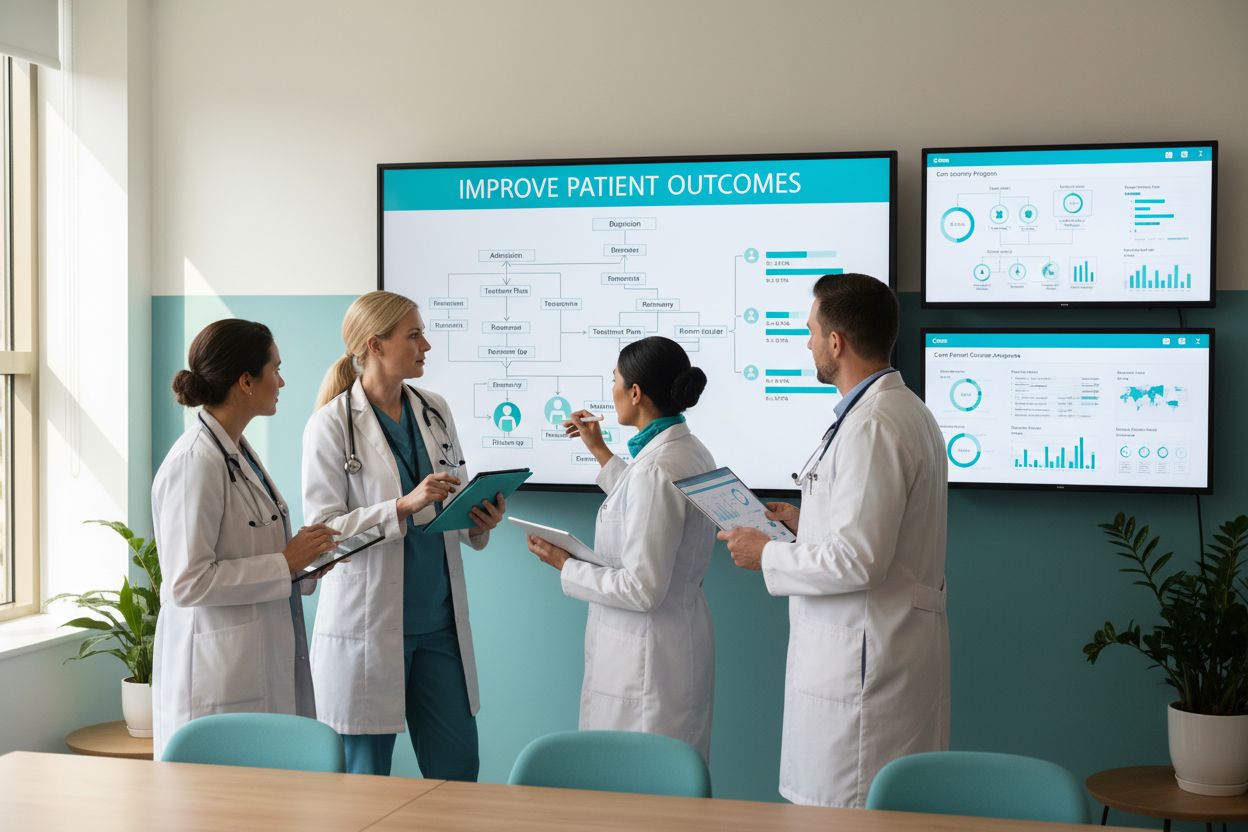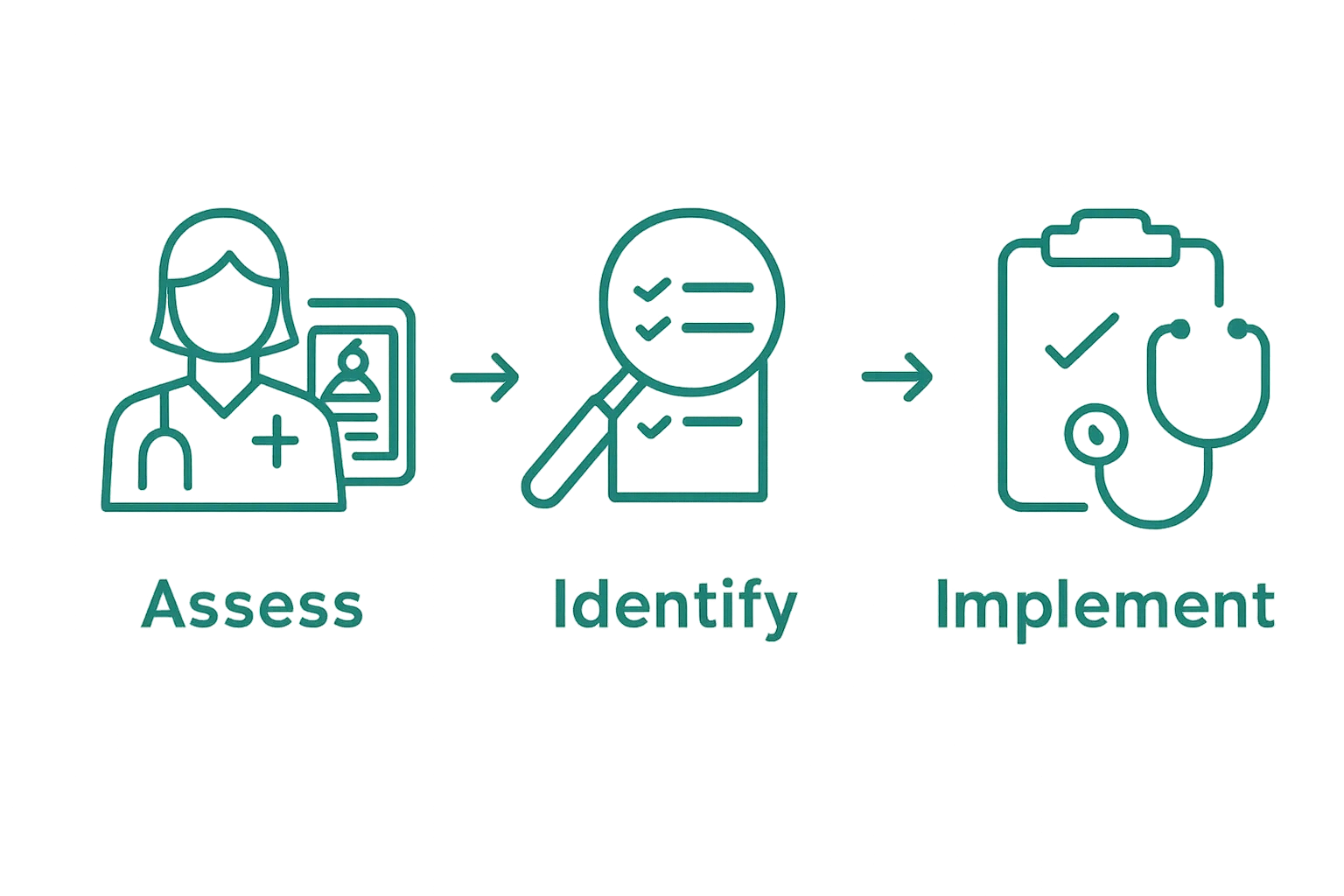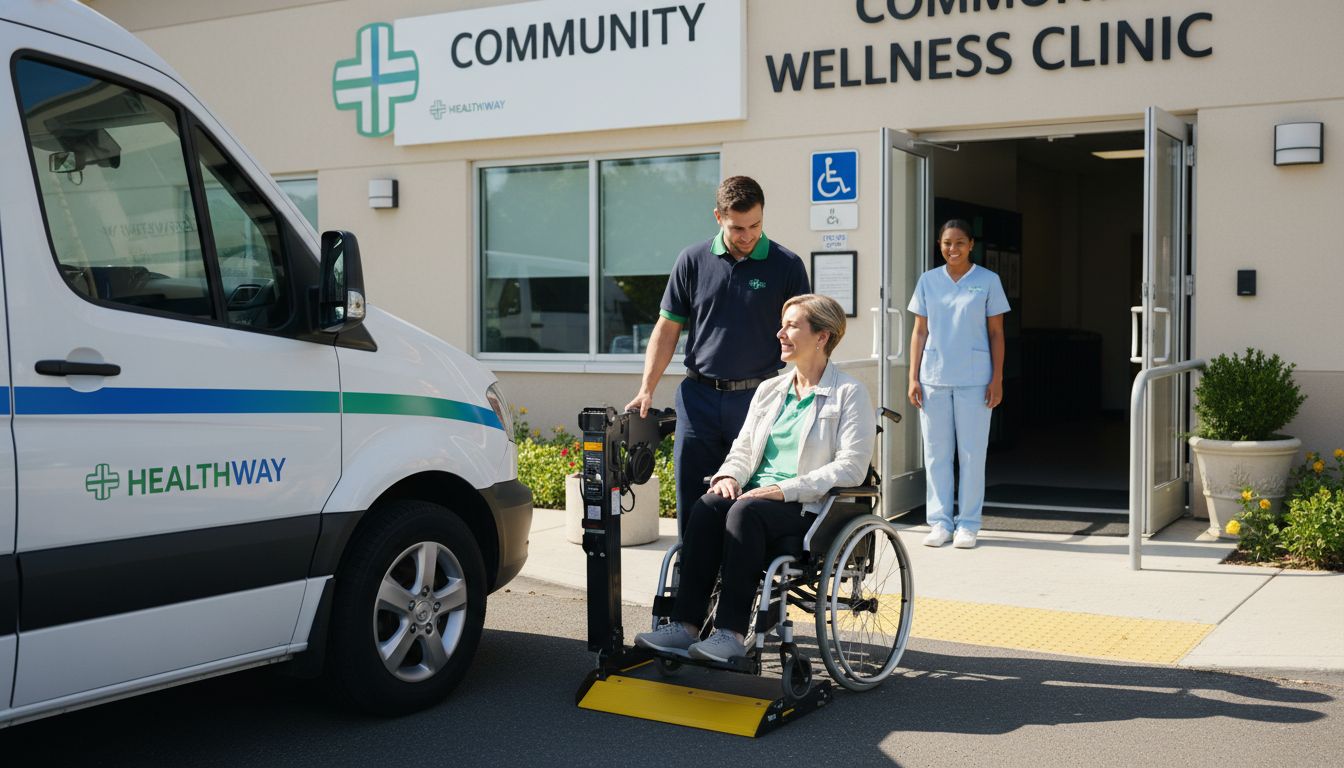How to Improve Patient Outcomes with Effective Strategies

Healthcare teams are always searching for ways to improve patient care, but most efforts stall at the starting line. It sounds surprising when you realize that most hospitals only use a fraction of their available data when reviewing patient outcomes. The real shift happens when organizations dig deep, mapping patient journeys and listening to feedback from every level of staff—because the secret to better results is often hiding in plain sight.
Table of Contents
- Step 1: Assess Current Patient Care Practices
- Step 2: Identify Areas For Improvement
- Step 3: Implement Evidence-Based Practices
- Step 4: Engage And Train Healthcare Staff
- Step 5: Monitor And Evaluate Patient Outcomes
Quick Summary
| Key Point | Explanation |
|---|---|
| 1. Assess current patient care practices | Conduct a thorough evaluation of existing patient care to identify bottlenecks and inefficiencies. |
| 2. Identify areas for improvement | Focus on high-impact areas by categorizing challenges and prioritizing based on potential outcomes. |
| 3. Implement evidence-based practices | Establish structured frameworks to integrate new, research-backed interventions effectively across healthcare teams. |
| 4. Engage and train healthcare staff | Create tailored training programs that enhance skills, teamwork, and communication for better patient care. |
| 5. Monitor and evaluate patient outcomes | Use a comprehensive metrics framework to track and analyze patient outcomes continuously for ongoing improvements. |
Step 1: Assess Current Patient Care Practices
Improving patient outcomes begins with a comprehensive and honest evaluation of your current care practices. This critical first step involves systematically examining how patients move through your healthcare system, identifying potential bottlenecks, and understanding existing performance metrics. A thorough assessment provides the foundation for targeted improvements and strategic interventions.
To conduct an effective assessment, start by gathering comprehensive data from multiple sources. Review electronic health records (EHRs), patient feedback surveys, clinical performance reports, and staff input. Look for patterns in patient wait times, treatment delays, readmission rates, and care coordination challenges. Learn more about patient logistics and assessment strategies to ensure a holistic approach.
Next, map out your current patient journey from initial contact through treatment and follow up. Document each touchpoint and interaction, noting where communication breaks down or inefficiencies emerge. Pay special attention to transitions between departments, handoff procedures, and communication protocols. Quantitative metrics are crucial: track indicators like average patient transfer times, interdepartmental communication delays, and care coordination effectiveness.
During this assessment, engage healthcare professionals at all levels. Conduct structured interviews with nurses, physicians, administrative staff, and support personnel to gain nuanced insights into systemic challenges. Their frontline experiences often reveal critical gaps that data alone might not expose. Create a safe environment where team members can share honest feedback about workflow obstacles and patient care constraints.
Key verification criteria for a successful assessment include:
- Comprehensive documentation of current patient care workflows
- Detailed performance metrics across key healthcare delivery indicators
- Identified system bottlenecks and communication breakdowns
- Staff and patient feedback compiled and analyzed
By meticulously examining your current patient care practices, you establish a solid baseline for future improvements.
Below is a checklist summarizing the key verification criteria for a successful assessment of current patient care practices.
| Verification Criteria | Description |
|---|---|
| Comprehensive documentation of workflows | Detailed mapping and recording of patient care processes |
| Detailed performance metrics | Collection of quantitative data (wait times, delays, etc.) |
| Identification of bottlenecks and communication gaps | Clear evidence of problems and breakdowns in care flow |
| Staff and patient feedback compiled | Insights and opinions gathered from all stakeholder levels |
| Analysis of feedback and metrics | Data and feedback reviewed to form actionable insights |

This foundational step transforms abstract goals into concrete, data driven strategies for enhancing patient outcomes.
Step 2: Identify Areas for Improvement
After completing a comprehensive assessment of current patient care practices, the next critical step is strategically identifying specific areas ripe for improvement. This process requires a systematic approach that transforms raw data into actionable insights, focusing on opportunities that will have the most significant impact on patient outcomes. Explore our insights on patient flow barriers to guide your strategic planning.
Begin by categorizing the issues uncovered during your initial assessment into distinct domains: clinical workflow, communication processes, technological infrastructure, and patient experience. Prioritize these areas based on their potential to directly influence patient care quality and overall system efficiency. Look for recurring patterns that suggest systemic challenges rather than isolated incidents.
Analyze performance metrics with a critical eye toward bottlenecks and inefficiencies. Pay particular attention to metrics like patient wait times, treatment delays, readmission rates, and care coordination gaps. Quantitative data provides objective evidence of where improvements can generate the most substantial benefits. Cross reference these metrics with qualitative feedback from staff and patients to develop a holistic understanding of potential intervention points.
Consider employing root cause analysis techniques to dig deeper into identified challenges. This involves systematically examining the underlying factors contributing to performance gaps. For instance, if patient transfer times are consistently long, investigate the specific administrative, technological, or communication barriers preventing smoother transitions. Understanding the fundamental causes allows for more targeted and effective interventions.
Key verification criteria for identifying improvement areas include:
- Comprehensive mapping of performance gaps across key healthcare delivery domains
- Prioritized list of improvement opportunities with potential impact assessments
- Root cause analysis documentation for primary systemic challenges
- Preliminary intervention strategies for top-priority improvement areas
Remember that identifying improvement areas is not about criticism but about creating opportunities for meaningful enhancement. Approach this step with a collaborative mindset, recognizing that every identified challenge represents a chance to elevate patient care and organizational performance. The goal is to transform data into strategic insights that drive measurable improvements in patient outcomes.
Step 3: Implement Evidence-Based Practices
Implementing evidence-based practices represents a critical transformation of your strategic insights into tangible improvements in patient care. This step bridges the gap between identification of challenges and actual systematic change, requiring a thoughtful and methodical approach. According to clinical research, successful implementation demands comprehensive planning and collaborative engagement across healthcare teams.
Develop a structured implementation framework that creates clear pathways for introducing new protocols and practices. Start by selecting evidence-based interventions directly aligned with the improvement areas identified in your previous assessment. This might involve adopting clinical guidelines, standardizing communication protocols, or integrating new technological solutions that enhance care coordination.
Education and training are fundamental to successful implementation. Design comprehensive training programs that not only explain new practices but also help healthcare professionals understand the rationale behind these changes. Provide multiple learning modalities including workshops, online modules, hands-on training sessions, and peer mentorship opportunities. Ensure that all team members understand not just the how, but the critical why behind each new practice.
Create a phased rollout strategy that allows for gradual implementation and real-time adjustment. Begin with pilot programs in specific departments or units, carefully monitoring performance and collecting feedback. This approach minimizes disruption and provides opportunities to refine practices before full-scale deployment. Establish clear metrics to track the effectiveness of each implemented practice, including patient outcomes, staff satisfaction, and operational efficiency.
Key verification criteria for evidence-based practice implementation include:
- Comprehensive training documentation for all involved healthcare professionals
- Detailed implementation timeline with specific milestones
- Baseline and ongoing performance metrics for new practices
- Mechanisms for continuous feedback and iterative improvement
Remember that implementing evidence-based practices is not a one-time event but an ongoing commitment to excellence. Remain flexible, receptive to feedback, and prepared to make nuanced adjustments as you observe real-world results. The goal is creating a dynamic, adaptive healthcare environment that continuously evolves to deliver the highest quality patient care.
Step 4: Engage and Train Healthcare Staff
Engaging and training healthcare staff is the critical human element that transforms strategic plans into successful patient care improvements. This step focuses on creating a culture of continuous learning, collaboration, and professional development that empowers your team to deliver exceptional patient outcomes. Learn more about advancing healthcare technology and training to support your staff development efforts.
Develop a comprehensive, multi-dimensional training strategy that goes beyond traditional one-size-fits-all approaches. Recognize that healthcare professionals have diverse learning styles, experience levels, and professional backgrounds. Create a flexible training ecosystem that includes interactive workshops, online learning modules, hands-on simulation experiences, peer mentorship programs, and regular skill refresh sessions. Personalization is key to effective staff engagement.
According to clinical research on staff engagement, successful training programs should emphasize not just technical skills but also communication, teamwork, and emotional intelligence. Design training modules that build strong interpersonal skills, teaching staff how to communicate effectively across disciplines, handle high-stress situations, and collaborate seamlessly. Include scenario-based learning that helps professionals develop adaptive problem-solving skills and emotional resilience.
Establish a supportive feedback mechanism that encourages continuous improvement and open dialogue. Create safe spaces for staff to share challenges, suggest improvements, and discuss their professional development goals. Implement regular performance reviews that are constructive and forward-looking, focusing on growth opportunities rather than punitive assessments. Recognize and reward staff members who demonstrate exceptional patient care, innovation, and commitment to continuous learning.
Key verification criteria for staff engagement and training include:
- Comprehensive training documentation with individual learning progress tracking
- Documented improvement in staff communication and collaboration metrics
- Staff satisfaction surveys showing positive engagement with training programs
- Measurable improvements in patient care outcomes directly linked to training initiatives
Remember that staff engagement is an ongoing journey. Continuously adapt your training approach, remain responsive to emerging healthcare challenges, and create an organizational culture that values professional growth, mutual respect, and exceptional patient care.
Here is a checklist table outlining the key verification criteria for successful engagement and training of healthcare staff.
| Verification Criteria | Description |
|---|---|
| Training documentation with progress tracking | Records of individual staff training completion |
| Improved communication and collaboration metrics | Measurable gains in teamwork and information sharing |
| Positive staff satisfaction survey results | Survey data reflecting increased engagement and satisfaction |
| Patient care improvements linked to training | Outcome data showing direct impact of training initiatives |
Step 5: Monitor and Evaluate Patient Outcomes
Monitoring and evaluating patient outcomes represents the crucial validation stage of your improvement strategy, transforming collected data into actionable insights. This step requires a systematic approach that goes beyond surface-level metrics to understand the deeper implications of your healthcare interventions. Explore strategies for improving patient monitoring to enhance your evaluation process.
Establish a comprehensive metrics framework that captures both quantitative and qualitative patient outcome indicators. Design a robust tracking system that monitors key performance metrics such as patient recovery rates, readmission frequencies, treatment effectiveness, patient satisfaction scores, and long-term health improvements. Integrate multiple data sources including electronic health records, patient feedback surveys, clinical assessments, and follow-up consultations to create a holistic view of patient outcomes.
Implement advanced data analysis techniques that move beyond traditional reporting. Utilize statistical methods and predictive analytics to identify trends, potential risks, and opportunities for further improvement. Create visual dashboards that make complex data easily understandable for healthcare professionals and leadership teams. Develop real-time monitoring capabilities that allow for immediate intervention when potential issues are detected, transforming your approach from reactive to proactive patient care.
Create a structured feedback loop that ensures continuous improvement. Schedule regular review meetings where multidisciplinary teams can discuss outcome data, share insights, and collaboratively develop refinement strategies. Encourage open dialogue that treats performance metrics as learning opportunities rather than punitive measures. This approach fosters a culture of transparency, continuous learning, and shared commitment to patient care excellence.
Key verification criteria for monitoring and evaluating patient outcomes include:
- Comprehensive data collection across multiple patient care dimensions
- Established baseline metrics and comparative performance benchmarks
- Regular interdepartmental review processes for outcome analysis
- Documented improvement strategies derived from outcome evaluations
Remember that outcome monitoring is an ongoing process of discovery and refinement. Stay adaptable, maintain a curious mindset, and view each data point as an opportunity to enhance patient care strategies. The ultimate goal is creating a dynamic, responsive healthcare system that continuously evolves to meet patient needs more effectively.

Transform Patient Outcomes with Real-Time Healthcare Logistics
You have seen how complex gaps and delays in patient care can directly impact outcomes, from missed handoffs and communication breakdowns to workflow bottlenecks that slow recovery. If these roadblocks are holding back your team’s potential, it is time to move beyond spreadsheets and fragmented processes. VectorCare combines the latest automation, secure communication, and AI-driven dispatch tools into one digital platform designed for today’s coordinated healthcare environments.

Imagine your organization running with seamless patient transfers, rapid home health coordination, and automatic updates to everyone involved. See how you can reduce delays, simplify operations, and boost satisfaction for patients and teams alike. Discover what is possible with VectorCare’s easy-to-integrate, compliance-ready system by visiting VectorCare’s homepage and exploring how our patient logistics platform or our guide to improving patient flow can help you take the first step. Start transforming outcomes today—do not let outdated processes stand in the way of better care.
Frequently Asked Questions
How can I assess current patient care practices?
To assess current patient care practices, start by gathering data from electronic health records, patient feedback surveys, and clinical performance reports. Map out the patient journey, documenting touchpoints and identifying bottlenecks and inefficiencies in care coordination.
What areas should I focus on for improvement in patient outcomes?
Focus on areas such as clinical workflow, communication processes, technological infrastructure, and patient experience. Prioritize them based on their potential impact on patient care quality and system efficiency.
How do I implement evidence-based practices in healthcare?
Develop a structured implementation framework by selecting evidence-based interventions aligned with identified improvement areas. Ensure comprehensive training, create phased rollouts, and establish metrics to monitor effectiveness.
What metrics should I use to monitor patient outcomes?
Use a comprehensive metrics framework that includes both quantitative indicators like recovery rates and readmission frequencies, as well as qualitative measures such as patient satisfaction scores. Regularly review and analyze this data to identify trends and opportunities for improvement.



